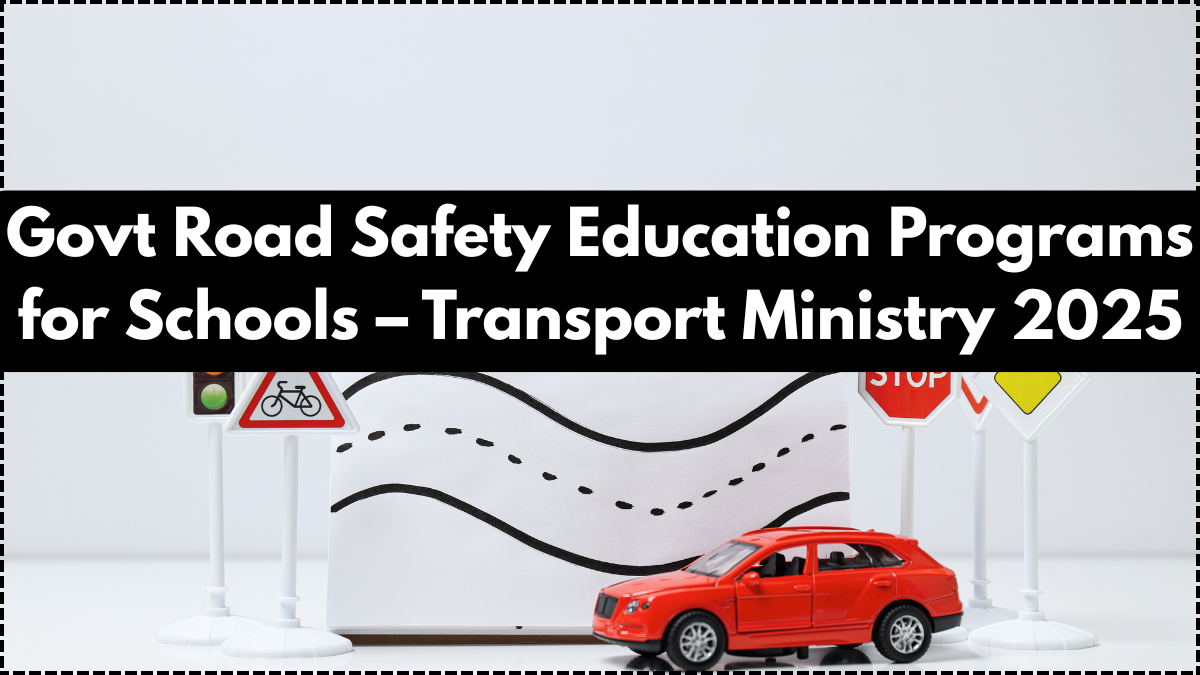Road safety starts with awareness—and there’s no better place to build that awareness than in schools. That’s why, in 2025, the Indian government has expanded its nationwide school road safety education India program to cover all states and union territories. With a growing number of road accidents involving school-age children, the Transport Ministry’s plan focuses on education, infrastructure awareness, and early behavior shaping.
The Transport ministry school program isn’t just a one-time workshop. It is a year-round curriculum integrated into primary and secondary education. Through visual aids, interactive modules, teacher training, and school-level safety audits, this initiative aims to create a new generation of responsible and informed road users.

Why Schools Are the Focus of Road Safety Awareness
Children are among the most vulnerable on Indian roads—whether walking to school, crossing intersections, or riding bicycles. The school road safety education India program is built on the principle that long-term behavioral change begins with early exposure. When students learn road rules in a structured, engaging way, they not only protect themselves but also influence family and community practices.
Key objectives of this school-based safety campaign include:
-
Teaching students basic traffic rules and safe pedestrian behavior
-
Training school bus drivers and attendants on student handling
-
Conducting mock drills on emergency response during accidents
-
Educating about helmet and seatbelt usage from a young age
-
Promoting safe cycling habits and designated travel zones
These lessons are not just taught in classrooms. The Transport ministry school program encourages hands-on activities like road-crossing simulations, field visits to traffic control rooms, and community awareness drives.
Key Components of the Transport Ministry School Program 2025
Component |
Target Group |
Method of Implementation |
Frequency |
|---|---|---|---|
Road Safety Curriculum Module |
Classes 3 to 12 |
Integrated in Social Studies & Life Skills |
Weekly or Bi-weekly |
Teacher & Driver Training |
Teachers, Bus Staff |
Online & In-person workshops |
Quarterly |
Road Safety Clubs |
Students (age 12–18) |
Peer-led sessions, poster drives, rallies |
Monthly |
Infrastructure Safety Audits |
School administration |
Checklist for gates, crosswalks, speed zones |
Annual or Bi-annual |
Digital Learning Tools |
All age groups |
AR-based games, animated videos, e-quiz portals |
Continuous access |
This model ensures that school road safety education India isn’t a one-size-fits-all approach—it’s tailored, engaging, and evolving with technology.
Technology and Innovation in Safety Education
To reach today’s students, the Transport ministry school program uses digital-first teaching methods. These include gamified apps, cartoon-based safety modules, animated traffic situations, and virtual road-crossing experiences. The curriculum also features real-life accident case studies (suitably edited for young audiences) to show the importance of safe behavior.
Innovations introduced in 2025 include:
-
Augmented Reality-based mobile app “SafePath” for classroom use
-
Voice-activated traffic rule learning devices for visually impaired students
-
QR-coded safety booklets that link to explainers in local languages
-
National Road Safety Quiz Championship with school participation from every district
These tools are especially effective in schools with limited infrastructure, allowing them to provide high-quality learning at low cost.
National Rollout and Government Monitoring
The scale of the school road safety education India initiative is unprecedented. The Transport Ministry, in partnership with the Ministry of Education, has set ambitious targets for implementation by the end of 2025. Over 2 lakh schools have already registered for the program through the Sarathi-Roadwise portal.
Highlights of the rollout:
-
Central database tracking school participation and progress
-
Mobile compliance teams for physical verification of training implementation
-
Partnerships with NGOs, traffic police, and local transport authorities
-
State education boards integrating safety modules into textbooks
The Transport ministry school program also works closely with parents, holding orientation sessions to extend safety conversations beyond the school gates.
Conclusion
The school road safety education India program in 2025 is a powerful and necessary initiative that lays the foundation for lifelong road discipline. Through the innovative and far-reaching Transport ministry school program, students are not just being taught—they are being empowered to become safety ambassadors in their homes and communities. This is more than an educational effort; it’s a cultural shift toward responsibility, awareness, and saving lives.
FAQs
What is the school road safety education India initiative?
It is a national program that brings structured road safety training into Indian schools, supported by the Ministry of Road Transport and Education.
What is included in the Transport ministry school program?
The program includes a school safety curriculum, teacher and driver training, student clubs, safety audits, and use of digital tools for road awareness.
Is this program mandatory for all schools?
As of 2025, it is being rolled out in all government and recognized private schools, with participation expected to be universal by 2026.
Are students being evaluated on this subject?
While there are no formal exams yet, schools are encouraged to conduct quizzes, projects, and competitions to reinforce the lessons.
How can schools enroll in this road safety initiative?
Schools can register on the Sarathi-Roadwise portal or contact their district education officer or transport authority for onboarding.
Click here to learn more